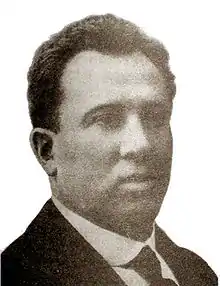Alexander Osipovich Drankov | |
|---|---|
 | |
| Died | January 3, 1949 (aged 68) |
| Nationality | Russian |
| Occupation(s) | Film producer, photographer, cameraman |
| Website | Alexander Osipovich Drankov on IMDb |
Alexander Osipovich Drankov (Russian: Алекса́ндр О́сипович Дранко́в; 1880 – 1949) was a Russian Empire and Soviet photographer, cameraman, film director, and film producer. He is considered a pioneer of Russian pre-revolutionary cinematography.[1]
Biography
Despite having no formal education, Alexander Drankov and his brother Lev founded a photography studio in Saint Petersburg. Alexander worked as a foreign photography correspondent for the Illustrated London News and L'Illustration, and was an official photographer for both the Duma and Nicholas II.[1]
1907-1908
In 1907, Alexander Drankov decided to start his own film-making business and opened "A. Drankov's Atelier" (Russian: Ателье А. Дранкова), which would soon transform into a joint-stock company "A. Drankov & Co". Drankov and his team began to shoot newsreels, him and his cameramen being habitual frequenters of every major event in both Saint Petersburg and Moscow until the October Revolution of 1917. Also, he started shooting feature shorts, such as Boris Godunov. This motion picture was never finished, though some of the materials shot for this movie were shown at cinemas in that same 1907 under the title Scenes from a Boyar Life. In 1908, Drankov took the first ever film of Leo Tolstoy.[2] After having failed to obtain the writer’s permission to film him, Drankov hid himself with a camera in a wooden outhouse in the garden of Tolstoy’s estate and shot the promenading writer through a small ornamental window.
The first motion picture produced by Drankov and released into movie theaters was a film called Stenka Razin. The first performance took place on October 15 (28) of 1908. For the first time in Russia, the movie was accompanied by the original sound (movie theaters would acquire the film together with the phonograph recording of music). The music score was written by a Russian composer Mikhail Ippolitov-Ivanov for the eponymous play by Vasily Goncharov to be staged at the "Aquarium Theater". The release of this film was also the first case of copyright infringement by a filmmaker in Russian history (Drankov never signed a formal contract with the screenplay writer and the composer).
Alexander Drankov’s next film was the first Russian comedy called Userdniy denshchik (Усердный денщик; 1908). At the same time, Drankov came up with a new type of movie advertising by publishing postcards with snapshots from his movies and also placing them on posters, which had never been done before. In 1908 he also directed The Big Man, The Marriage of Krechinsky and produced The Diligent Batman.
1909-1916
In 1909 he directed the film Taras Bulba, based on the novel by Nikolai Gogol.
With the onset of Alexander Khanzhonkov’s activities in the movie industry, Drankov became quite unsettled. Upon making his acquaintance with Khanzhonkov and finding out about his plans to produce a film called Pesn’ pro kuptsa Kalashnikova, Drankov decided to sabotage the release of this film by making a pre-emptive release of an eponymous deliberate box office failure. When Khanzhonkov found out about Drankov’s intentions, he sped up the making of his film and then managed to release it before Drankov was able to finish his competing film. After this incident, the rivalry between Khanzhonkov and Drankov soon became one of the main intrigues of the Russian cinematographic life, occasionally leading to the release of almost identical films, e.g. Votsareniye Doma Romanovykh (1913; produced by Khanzhonkov) and Tryoksotletiye tsarstvovaniya doma Romanovykh (1913; produced by Drankov).
Alexander Drankov was the first one in Russia to start producing crime films, which had only recently come into fashion in France. His serial film called Son’ka – Zolotaya Ruchka (1914–1915) was an unprecedented success in Russia.[3][4]
1917-1949
In 1917, Drankov tried to make a market of the revolutionary events in Russia by releasing a few "revolutionary" movies, such as Georgy Gapon and Babushka russkoy revolutsii (both 1917), but after the October Revolution he decided to leave Saint Petersburg.
In November 1920, he emigrated to Constantinople, where he made his living by either organizing cockroach racing events, according to one account, or by film distribution and maintaining an amusement park, according to another account. In 1922, Drankov moved to the United States of America, where he would buy a mobile cinema projector and show films to Russian immigrants. In 1927, he made an attempt to return to film-making business, but his intention to shoot a major film about a love affair between Nicholas II and ballerina Mathilde Kschessinska turned out to be a failure. After his unsuccessful attempt to gain a foothold in Hollywood, Alexander Drankov opened a café in Venice, California, but soon moved to San Francisco, where he would work in his own photo company until his death on 3 January 1949 in San Francisco. He is buried in Colma, California.
References
- 1 2 Peter Rollberg (2009). Historical Dictionary of Russian and Soviet Cinema. US: Rowman & Littlefield. pp. 194–196. ISBN 978-0-8108-6072-8.
- ↑ Andrew D. Kaufman, "Authentic Film Footage of Leo Tolstoy" Archived 2010-04-06 at the Wayback Machine, 2006
- ↑ Denise Jeanne Youngblood (1999). The Magic Mirror: Moviemaking in Russia, 1908-1918. Univ of Wisconsin Press. p. 60. ISBN 978-0-299-16234-4.
- ↑ Ken Wlaschin (2009). Silent Mystery and Detective Movies: A Comprehensive Filmography. McFarland. p. 210. ISBN 978-0-786-44350-5.